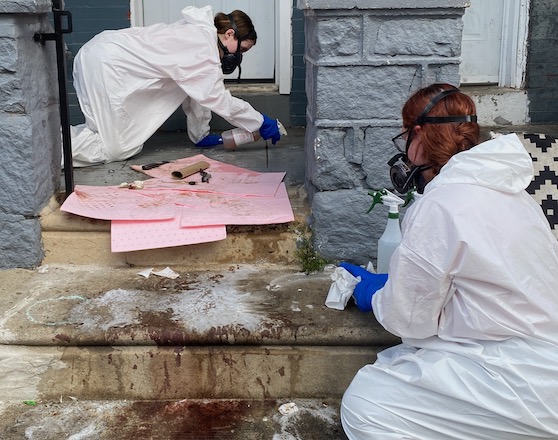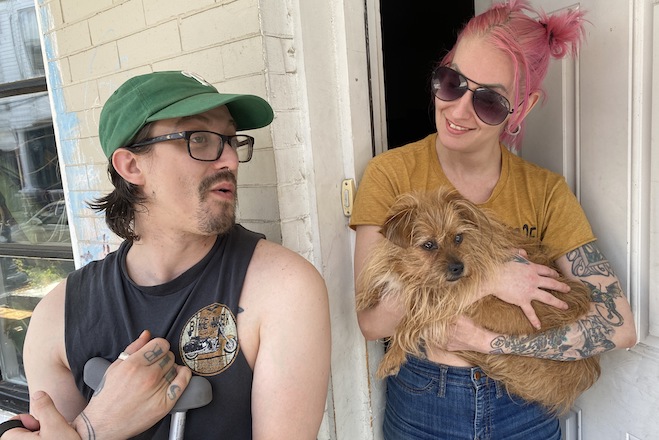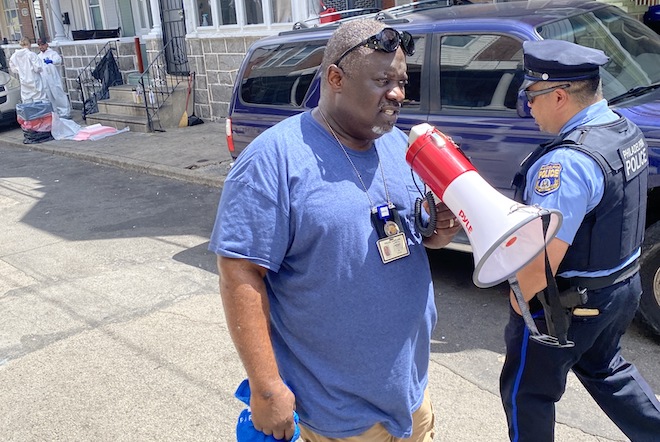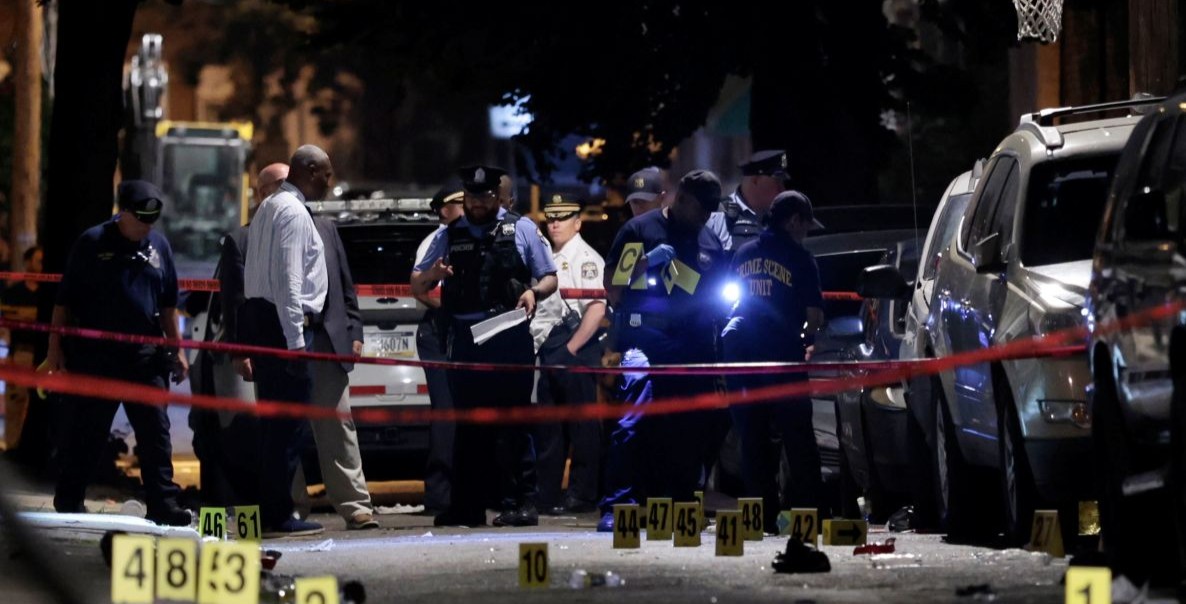Residents of the 1500 block of South Etting Street in South Philadelphia spent the morning after the Fourth of July weekend watching police officers circle, then collect, fragments of bullet shell casings from their porches, sidewalks, and street. When the police cleared out, biohazard service employees — hired by the city and clad in white Hazmat suits and respirator masks — came in and began scrubbing away blood from wherever it had fallen.
Just after 1am on Monday, July 7, 13 people were shot, three fatally, on this narrow one-way street in the Grays Ferry community. It was one of the worst mass shootings in Philadelphia in recent years, but not the only one to occur in recent days. And while city officials stress that homicides are down nearly 10 percent compared to this time last year, residents of South Etting Street and neighboring blocks are fearful. They wonder if the shootings that shattered the peace during the long holiday weekend could signal that progress to curb them has come to an end.
[This story was originally published by The Trace, a nonprofit newsroom covering gun violence in America. Sign up for its newsletters here.]
At the height of Philly’s gun violence crisis, more than 500 lives were lost in 2020 and again in 2021. This year, since July 1, 57 people have been shot, seven fatally, making this month Philadelphia’s most violent so far. July 7 was also the most violent day of 2025, with a staggering 23 people being added to the list of gunshot victims.
The shootings, coupled with a sanitation workers’ strike in its second week, are testing Mayor Cherelle Parker’s personal mandate and mantra to make Philadelphia the “safest, cleanest and greenest” big city in the nation. Some South Etting Street residents said the smell of piled-up trash in the summer heat may be triggering some to lash out in violence.
While Police Commissioner Kevin Bethel rejected that theory, he conceded that shootings typically rise during warmer months. “In the summertime we always, always have an increase in violence,” he says. “We can look at our three-year trend and see that July is a month where we will have one of our highest levels of violence. We recognize that. … We’re working diligently to address that.”
 Employees of Trauma Services, a biohazard removal company, cleaning blood from steps. Photo by Mensah Dean.
Employees of Trauma Services, a biohazard removal company, cleaning blood from steps. Photo by Mensah Dean.
“People are more agitated.”
The 13 South Etting Street victims included three men, ages 19, 23 and 24, who died of their wounds. There were three juveniles injured: a 15-year-old girl and two 17-year-old boys. The other victims were men and women between ages 18 and 24. The shooting came as the city was already trying to fight an increase in youth violence.
Tyrique Glasgow, founder of the Young Chances Foundation, which mentors children in South Philadelphia, says that while statistics show that the city’s decline in shootings last year were among the lowest in decades, those figures are deceptive because they’re being compared to the record-high shootings during the Covid era, and because young men in the most violent communities are still killing and dying.
“They know that the people who are most likely to shoot or be shot is at an all-time high,” he says, after taking a break from huddling with South Etting Street residents.
“The weather is hotter; we’re getting on each other’s nerves. So people are more agitated,” says Geneva Carter, 62, who has lived in Grays Ferry her entire life. “It’s like being in a crowded house, but this is a crowded neighborhood.”
“We will not go back to the times when we had 560-plus homicides. That is not happening.” — Police Commissioner Kevin Bethel
A woman who gave her name as Shay, who sat on her porch watching the cleaning crew, scoffed at city officials’ talking points, saying they are misinformed because they “aren’t in the streets. They behind a desk,” she says.
Shay and her four kids dropped to the ground when the shooting started. “There were a lot of kids out here,” she says. She’s now looking for a new home for her family. “It’s a hot mess down here. It’s too much drama. It’s never peaceful.”
Dennis Petrakis, 36, and his partner, Sara Crosby, 34, live directly across the street from the house where the most blood stained the porch and steps. They initially thought the rapid explosion of sound they’d heard in the wee hours on Monday was fireworks set off by someone in a crowd of about 100 partygoers on the street.
The morning sun revealed the extent of the fallout. On their porch and steps were chalk circles where police investigators had found bullet fragments. “One of our windows took a bullet,” Crosby says. “And my car has four bullets and a flat tire,” Petrakis says.
“I’ve lived in Philly 16 years now, and this is the worst house I’ve lived in, probably,” Petrakis says. “I hope they get the blood on my car that they haven’t seen yet,” he said while watching the biohazard crew.
“It is unsettling,” Crosby says.
“But I didn’t get hurt; my family didn’t get hurt. I feel bad for whoever did,” Petrakis adds.
 Dennis Petrakis (left) and Sara Crosby with dog Eevee discuss the mass shooting on their block. Photo by Mensah Dean.
Dennis Petrakis (left) and Sara Crosby with dog Eevee discuss the mass shooting on their block. Photo by Mensah Dean.
On Monday, Bethel says investigators were still searching for the shooters and their motive. Given that more than 150 shots were fired, investigators believe that one of the guns was equipped with a switch device that enables it to fire like a machine gun.
A video of the shooting released by police shows three men on a house porch shooting at unseen targets amid a crush of terrified bystanders taking cover all around them. Two more shooters are seen standing in the street firing at the unseen targets.
An hour-and-a-half after the bloodletting on South Etting Street, four men between the ages of 18 and 22 were shot on the 6100 block of Vine Street in West Philadelphia. One of them was in critical condition while three were stable, authorities said. Twice as many people were shot at a Washington Avenue after-hours bar in the first mass shooting of the holiday weekend, just after 4am on July 5. No arrests have been made in any of the multi-victim shootings, police said.
The shootings continued through the evening of July 7. At 9:30pm, two men, ages 19 and 55, were shot on the 2900 block of North 12th Street in North Philadelphia. Both were in stable condition. A gun and 18 bullet casings were recovered from the scene, police said.
A triple shooting in the city’s Strawberry Mansion neighborhood capped the night just after 11:30pm. That attack left a man in critical condition, and an 18-year-old man and a 16-year-old boy in stable condition. Police recovered a gun and bullet casings from 9mm and 380 caliber handguns.
 Police Department Chaplain Moses Cotton used a bullhorn to offer words of comfort to South Etting Street residents. Photo by Mensah Dean.
Police Department Chaplain Moses Cotton used a bullhorn to offer words of comfort to South Etting Street residents. Photo by Mensah Dean.
Despite the burst of violence that ushered in July, Bethel says he’s confident that his department’s crime-fighting efforts are paying off given that the number of homicides and shootings remain lower than at this time last year. As of July 7, there have been 121 homicides, compared to 133 at the same time last year, a 9 percent reduction; there have been 547 shooting victims this year compared to 567 last year, a 3.5 percent drop, according to Police Department data.
“Yes, we had a significant level of violence over the weekend, but we can continue to see our trends are not heading in the opposite direction,” he says. “We will not go back to the times when we had 560-plus homicides. That is not happening.”
The residents of South Etting Street remain skeptical. “I think you should not say stuff like that because what do you do? You jinx yourself,” Carter says. “Not to be superstitious, but when they keep saying this on the news, it opens a can of worms.”
Mensah Dean is a staff writer at The Trace. Previously he was a staff writer on the Justice & Injustice team at The Philadelphia Inquirer, where he focused on gun violence, corruption and wrongdoing in the public and private sectors for five years. Mensah also covered criminal courts, public schools and city government for the Philadelphia Daily News, the Inquirer’s sister publication.
![]() MORE FROM THE TRACE
MORE FROM THE TRACE
Photo by Elizabeth Robertson, © 2025 Copyright The Philadelphia Inquirer. Credit: Associated Press
